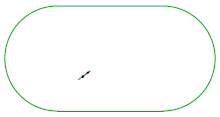
A dynamical billiard is a dynamical system in which a particle alternates between free motion (typically as a straight line) and specular reflections from a boundary. When the particle hits the boundary it reflects from it without loss of speed (i.e. elastic collisions). Billiards are Hamiltonian idealizations of the game of billiards, but where the region contained by the boundary can have shapes other than rectangular and even be multidimensional. Dynamical billiards may also be studied on non-Euclidean geometries; indeed, the first studies of billiards established their ergodic motion on surfaces of constant negative curvature. The study of billiards which are kept out of a region, rather than being kept in a region, is known as outer billiard theory.
The motion of the particle in the billiard is a straight line, with constant energy, between reflections with the boundary (a geodesic if the Riemannian metric of the billiard table is not flat). All reflections are specular: the angle of incidence just before the collision is equal to the angle of reflection just after the collision. The sequence of reflections is described by the billiard map that completely characterizes the motion of the particle.
Billiards capture all the complexity of Hamiltonian systems, from integrability to chaotic motion, without the difficulties of integrating the equations of motion to determine its Poincaré map. Birkhoff showed that a billiard system with an elliptic table is integrable.